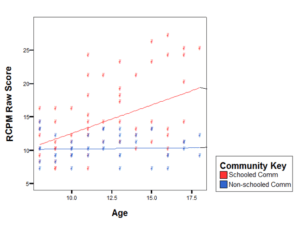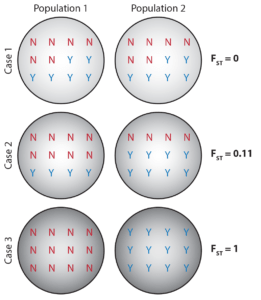Large Projects
The Roots of Intelligence: Causal Effects of Education on Cognition and Culture
 Formal education is often assumed to influence the content of our minds—what we know—but several new lines of evidence increasingly suggest that the effect of education runs far deeper: raising IQ, increasing analytic thinking, empowering self-regulation, and improving executive function. In other words, schooling not only transmits knowledge, but shapes core aspects of our cognition and behavior. The problem is that while correlations are easy to find, causality is more difficult to establish. Take IQ for example—the correlation between education and IQ is well known the effect of education on cognition and behavior. Formal education has spread to most corners of the globe, at least to some degree. This is a boon to human development, but a challenge to causally studying the effects of education on psychology and society.
Formal education is often assumed to influence the content of our minds—what we know—but several new lines of evidence increasingly suggest that the effect of education runs far deeper: raising IQ, increasing analytic thinking, empowering self-regulation, and improving executive function. In other words, schooling not only transmits knowledge, but shapes core aspects of our cognition and behavior. The problem is that while correlations are easy to find, causality is more difficult to establish. Take IQ for example—the correlation between education and IQ is well known the effect of education on cognition and behavior. Formal education has spread to most corners of the globe, at least to some degree. This is a boon to human development, but a challenge to causally studying the effects of education on psychology and society.
I’m hoping to resolve the causal issue in two ways: (1) by predicting the rise in IQ scores (Flynn effect) over time using an instrument for development and (2) by studying the introduction of schools to populations that previously did not have them in Namibia, Vanuatu, and Bolivia.
[read more=”EXPAND” less=”COLLAPSE”]
The manner in which schools are being introduced in these places allows for the examination of education as a natural experiment. Pilot data from the Bolivian site clearly demonstrates a causal effect of education on IQ (as well as on various other aspects of cognition). In our society, we assume IQ tests need to be re-normed to account for increasing performance with age. These initial results suggest that the re-norming is for exposure to schooling. Without access to schooling, IQ test performance remains flat with age (see graph above for Raven’s Colored Progressive Matrices).
It’s not just IQ. Common executive function has been found to be nearly 100% heritable based on data from twin studies. Executive function is crucial to academic achievement and if current heritability estimates are accurate, interventions designed to improve executive function (and therefore academic achievement) may be useless. However, if executive function is actually highly influenced by schooling, but most Western schooling meets some minimum threshold, this would create the illusion of 100% heritability. Only studying the changes in executive function between schooling and no-schooling would allow us to eliminate this explanation. And more importantly, only such an experiment would allow us to understand the specific ways in which schooling affects executive function in order to design more effective interventions. In general, the effect of genes and environment are difficult to disentangle, but a natural experiment with schooling vs no-schooling, that also measures parental abilities, genetic relatedness, and demographics would allow us to more definitively resolve these puzzles.
Theoretical motivation
The theoretical framework guiding the investigation is Dual Inheritance Theory and cultural evolution. To support innovation and increasingly sophisticated technologies, practices, and also ways of thinking (e.g. logic and abstraction), mechanisms to increase the fidelity and dissemination of information between generations co-evolve alongside the rest of culture (see Muthukrishna & Henrich, 2016). We see a progression where observational learning without explicit teaching suffices when technologies and practices are easy to learn, through to deliberate slowed down demonstration of techniques, to explicit teaching, formal apprenticeships, formal education, and finally compulsory formal education and education for longer and longer periods of time.
Since many of the psychological shifts brought on by education have been historic, it’s difficult to causally test these theories, hence my excitement about Vanuatu, Bolivia, and Namibia. These may offer a fleeting, final chance to understand the profound effect schooling has had on our psychology.
We can gain a deeper understanding of the effect of formal schooling on a rich set of psychology that is likely unique to Western Educated Industrialized Rich Democratic (WEIRD) societies, but that we take for granted. With this data, we can go beyond simply cataloguing differences to understanding the causal origins of psychological shifts, including the very foundations of cognitive ability and IQ. Indeed, these data may be the smoking gun that finally resolves the mystery surrounding the Flynn effect—the rise in IQ over time.
[/read]
Cultural Brains and Collective Brains
 This project has many sub-projects. The goal is to knit together a Theory of Human Behavior, grounded in our biology and evolutionary history, but that helps explain societal-level phenomenon, such as innovation and corruption. Core this to mission is the Cultural Brain Hypothesis (currently under review, but which won the top dissertation award in the social sciences) – an explanation for our large brains, large social groups, long juvenile period, and heavy reliance on social learning – and the Collective Brain (2016) – an explanation for human innovation, based on what happens when cultural brains are connected in our societies and social networks.
This project has many sub-projects. The goal is to knit together a Theory of Human Behavior, grounded in our biology and evolutionary history, but that helps explain societal-level phenomenon, such as innovation and corruption. Core this to mission is the Cultural Brain Hypothesis (currently under review, but which won the top dissertation award in the social sciences) – an explanation for our large brains, large social groups, long juvenile period, and heavy reliance on social learning – and the Collective Brain (2016) – an explanation for human innovation, based on what happens when cultural brains are connected in our societies and social networks.
Sub projects include:
- Understanding other aspects of our life history, such as the evolution of menopause (which may be a logical consequence of the Cultural Brain Hypothesis)
- Understanding the cultural evolution of overconfidence and how it affects entrepreneurship and the innovation rate
- Understanding the evolution of the division of labor and specialization as an adaptation to the rapidly accumulating body of information and technology
- Understanding the breakdown of cooperation based on zero-sum beliefs and zero-sum realities
- Understanding the dynamics of corruption as lower-order cooperation (such as family loyalty) undermining higher-order cooperation (such as anonymous cooperation within a meritocracy)
- Identifying the “invisible pillars” that support successful democracies and successful economies – cultural norms, such as belief in rule of law and equality that support successful institutions. This project prompted the creation of the Cultural Distance tool (see next project)
Critical Tools
Measuring Cultural Distance: A WEIRD Scale
 People have a sense that cultures differ and can probably list some of the ways in which they differ. What we lack is a robust and defensible method for quantifying the size and dimensions of those differences. The Cultural Distance tool takes a method from population genetics used to quantify the genetic distance between populations and applies it to large scale surveys of cultural values, such as the World Values Survey. These distances can be visualized using a variety of techniques from bioinformatics.
People have a sense that cultures differ and can probably list some of the ways in which they differ. What we lack is a robust and defensible method for quantifying the size and dimensions of those differences. The Cultural Distance tool takes a method from population genetics used to quantify the genetic distance between populations and applies it to large scale surveys of cultural values, such as the World Values Survey. These distances can be visualized using a variety of techniques from bioinformatics.
There are many applications of the tool. For example:
- A WEIRD (Western Educated Industrialized Rich Democratic) scale looking at how different sampled populations are from a comparison country (e.g. United States). Basically, how WEIRD is your sample?
- An alternative to genetic, physical, or linguistic distance, with many advantages over these proxies – it allows you to measure culture directly.
- A policy tool for assessing the dimensions that predict successful integration (i.e. how hard do we need to work to integrate different cultures to reap the benefits of diversity without paying the social costs of segregation).
- A corporate tool for understanding corporate cultural differences during acquisitions and mergers, or in cooperation between country offices.
- Answering question such as: Is there a global culture of rich, highly education, high mobile individuals? Are regional differences better represented by poorer, less educated, less mobile individuals?
To play with a beta version of the cultural distance tool, visit culturaldistance.muth.io.
The Database of Religious History

I designed the Database of Religious History (DRH) during graduate school and currently serve as the Technical Director for the project. The DRH aims to be the world’s largest online quantitative and qualitative encyclopedia of religious and social history. The key to the project is the spatio-temporal backbone – all variables are situated in space and time giving us a window into what was happening anywhere in the world at any time in history.
I designed this project, because we currently lack the data to test many theories in cultural evolution. Our first test will be the role religion has played in the rise of large-scale civilization, but the project promises to help answer far more questions, from what predicts the emergence and spread of ideas to the historical roots of modern cross-cultural differences.
For more information, visit the religiondatabase.org.







